More specifically, when is Bob Clampett’s birthday? Today would mark his 110th, so to honor Clampett’s anniversary, here is a special treat: an animator draft/breakdown video of Bob’s first directorial job in animation!
 As mentioned in the write-up for Porky’s Badtime Story, before Bob Clampett began supervising Looney Tunes for Leon Schlesinger, Clampett planned on leaving Schlesinger’s. Clampett hoped to produce a series of animated films based on John Carter of Mars, derived from a series of novels by Edgar Rice Burroughs. Burroughs and his son John Coleman supported Bob’s vision, but MGM—the project’s potential distributor—suggested a series based on Tarzan of the Apes, already a hit film series for Metro.
As mentioned in the write-up for Porky’s Badtime Story, before Bob Clampett began supervising Looney Tunes for Leon Schlesinger, Clampett planned on leaving Schlesinger’s. Clampett hoped to produce a series of animated films based on John Carter of Mars, derived from a series of novels by Edgar Rice Burroughs. Burroughs and his son John Coleman supported Bob’s vision, but MGM—the project’s potential distributor—suggested a series based on Tarzan of the Apes, already a hit film series for Metro.
During July and August 1936, Clampett, now out of his contract with Schlesinger’s, worked with John Coleman Burroughs to assemble a crew of artists—including Chuck Jones as a head animator—for their new studio, incorporated as “Tarzantoons.” But, Clampett grew unenthusiastic over the proposed Tarzan cartoons and withdrew from the project altogether. Leon Schlesinger contacted Clampett to rearrange his contract, promising a higher salary and a chance to direct whenever a vacant directorial position appeared. That autumn, Schlesinger assigned Clampett to direct an animated Technicolor segment for a live-action feature, When’s Your Birthday?
The production draft for the animated segment seems to indicate that animation began on September 27, 1936, insofar as the third week of footage counts includes a tiny written indication of “Oct.” above the ninth of the month. Alternately, the drafts list the finish date—just under two months later—as December 15, suggesting a start date of October 27, and the notion that the handwritten “Oct.” could be in error.

Henry Taylor
Another current-media reference follows when the professor spins the astrological chart like a carnival prize game, delivering a “round-and-round” spiel derived from The Major Bowes Amateur Hour, then a popular radio talent show. (A pop-culture nod also occurs when the professor’s speech briefly alludes to the Chicago World’s Fair, otherwise known as A Century of Progress World’s Fair, which operated from May 1933 until October 1934.)
In his new role as director, Clampett drew the segment’s character layouts and animated the principal scenes of Taurus the Bull arrogantly lording over the other astrological symbols. Clampett engaged his colleagues Chuck Jones and Bobe Cannon on the assignment. Cannon, like Clampett, took on a new position for the project: rather than just being tasked as an in-betweener for Jones, Cannon was also dispensed a few scenes to animate and in-between singlehandedly, in perhaps his earliest-known work as a full animator.
Clampett also used Cal Dalton, from Friz Freleng’s unit, to handle different scenes. Dalton had animated for Romer Grey and Ted Eshbaugh in the early 1930s, and at Harman-Ising, between stints at Schlesinger’s; Clampett might have felt the sequence could be finished quickly by a seasoned animator.
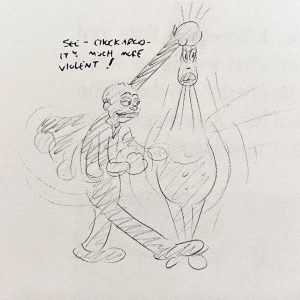
This gag drawing of production manager Ray Katz using Chuck Jones as a punching bag parallels scene 27 of Saggitarius punching Taurus in a similar fashion, suggesting this was drawn during the segment’s production.
In comparing the production draft and the final sequence, we find that several scenes of full animation are absent in the feature. The draft cites the finished sequence as comprising 349 total feet—nearly four minutes, whereas the segment in the film contains only about two-and-a-half minutes of completed animation. It is possible that RKO, or the producers of When’s Your Birthday, made edits to the sequence before the film’s release on February 19th, 1937. Processing three-strip Technicolor elements for a four-minute sequence might have been a handicap between the completion of its animation in December and the film’s release—a possible explanation for the excised scenes. In the currently circulating black-and-white version, there is a jump splice between the camera zooming through the planets in scene 2 and the establishing shots of astrological heaven in scene 4; a scene involving the Milky Way initially occurred between these shots, as listed in the draft.
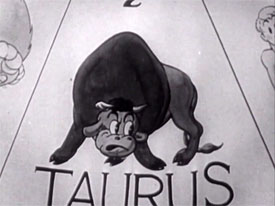 In scene 27, Taurus enters from the right and is knocked to the ground by a prizefighting Sagittarius. The draft shows that in deleted scenes 25 and 26, Taurus was to have endured attacks from a pair of twins resembling Gemini. Scene 26’s description of a machine gun and a fairy goose spinning Taurus around a merry-go-round might hint at why the bull dizzyingly spins into the frame in scene 27. The finished sequence ends in scene 27A of the defeated Taurus; however, it seems that additional footage, reflecting a later portion of the feature, had Taurus regaining his strength and fighting the Zodiac signs, one after another. Ultimately, these scenes are missing in the film—or at least in the version that survives today.
In scene 27, Taurus enters from the right and is knocked to the ground by a prizefighting Sagittarius. The draft shows that in deleted scenes 25 and 26, Taurus was to have endured attacks from a pair of twins resembling Gemini. Scene 26’s description of a machine gun and a fairy goose spinning Taurus around a merry-go-round might hint at why the bull dizzyingly spins into the frame in scene 27. The finished sequence ends in scene 27A of the defeated Taurus; however, it seems that additional footage, reflecting a later portion of the feature, had Taurus regaining his strength and fighting the Zodiac signs, one after another. Ultimately, these scenes are missing in the film—or at least in the version that survives today.
Clampett gave John Carey, like Bobe Cannon, a promotion from in-betweener to animator with at least two small bits of animation in the fight, but Carey’s footage was excised in the editing process. But, as noted in one of my previous write-ups, Carey would emerge as a full animator not long afterward, with a scene in Badtime Story when Porky and Gabby “quietly” punch the time clock at their workplace.
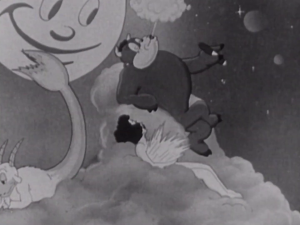 Samuel Wineland, credited for the musical score in When’s Your Birthday, peppers the animated sequence with “When The Moon Comes Over the Mountain,” a hit tune popularized by its co-writer Kate Smith in 1931, and the “Toreador March” from Georges Bizet’s opera Carmen, commonly used for bullfighting scenes in animated films. When Sagitarrius readies his arrow with the boxing glove, the professor notes the archer’s resemblance to William Tell—naturally, Rossini’s “William Tell Overture” plays in the background.
Samuel Wineland, credited for the musical score in When’s Your Birthday, peppers the animated sequence with “When The Moon Comes Over the Mountain,” a hit tune popularized by its co-writer Kate Smith in 1931, and the “Toreador March” from Georges Bizet’s opera Carmen, commonly used for bullfighting scenes in animated films. When Sagitarrius readies his arrow with the boxing glove, the professor notes the archer’s resemblance to William Tell—naturally, Rossini’s “William Tell Overture” plays in the background.
As previously noted, the cartoon sequence in When’s Your Birthday was initially released in Technicolor, contained within a black-and-white film. Unfortunately, the archival holdings of the original film elements are currently unknown, with only black-and-white copies, presumably intended for its television presentation, accessible. Perhaps this will change someday, letting viewers appreciate Bob Clampett’s first directorial work in its original Technicolor form.
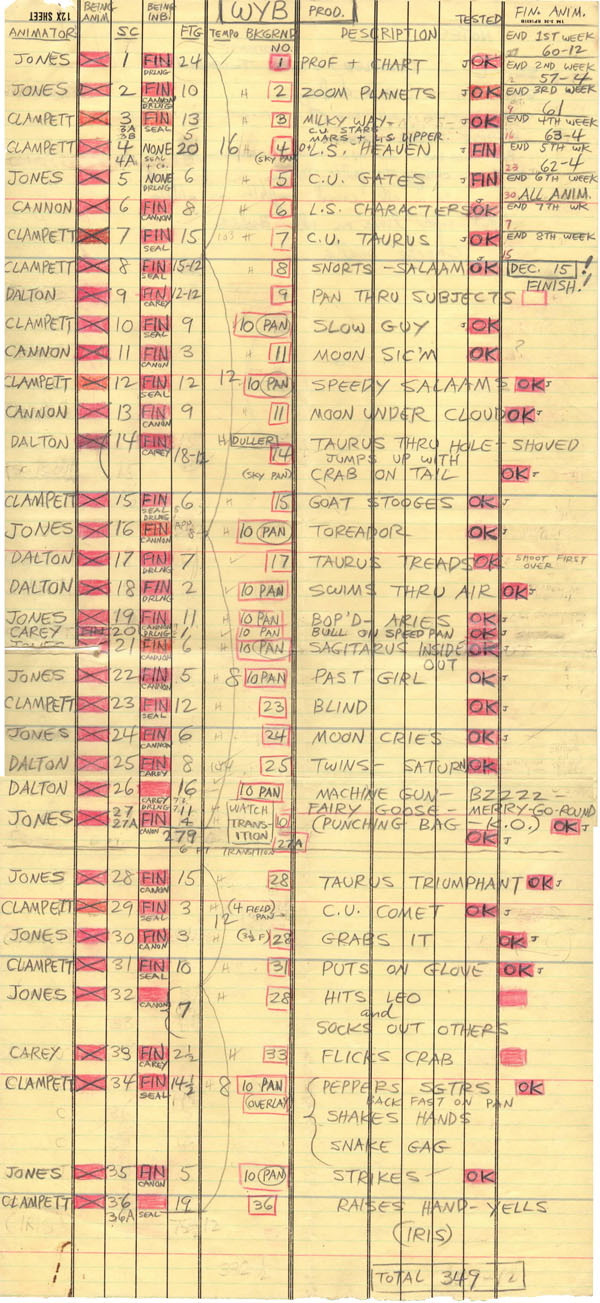
(Thanks to Jerry Beck, Ruth Clampett, Michael Barrier, Milton Gray, Keith Scott, Frank M. Young, Eric Costello, and David Gerstein for the materials and information used in the text.)


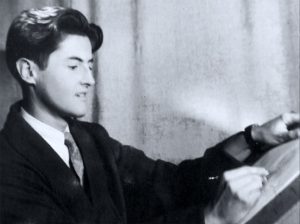
 DEVON BAXTER is a film restoration artist, video editor, and animation researcher/writer currently residing in Pennsylvania. He also hosts a
DEVON BAXTER is a film restoration artist, video editor, and animation researcher/writer currently residing in Pennsylvania. He also hosts a 





















































































Oh, my stars! I’m astounded that a production draft still exists for such a historically significant, yet rarely seen, piece of animation: Clampett’s first work as director, and Cannon’s as full animator. I’ve been a fan of Joe E. Brown ever since I saw “Alibi Ike” on the afternoon movie show while home sick from school. His early films are very hard to come by nowadays, and I have to confess that I never even heard of “When’s Your Birthday?” until today. The animated sequence isn’t really very funny, or even all that good by the standards of 1937; perhaps it would benefit if we could see in in Technicolor without any cuts. But we’re lucky to have even this fragment in black-and-white!
I was amused that Taurus had pride of place among all the signs of the zodiac. After all, Bob Clampett was a Taurus himself.
These breakdowns keep getting better and better! Well done!
Bob Clampett sure was pretty when he was young.
Thanx Devon… I didn’t even know this existed.
Can’t have too much Clampett!
Happy Birthday, Wacky Bob!
Are there good prints of this Joe E. Brown film in circulation? I think the film is P.D. – and I’ve heard that the features under an independent producer – that released his product through RKO – was something of a “penny pincher,” so I’m surprised to learn that the animated sequence was originally done in color. I’m also surprised that Clampett and his team of animators worked on it. I had no idea! So, I’d like to see if – if decent prints exist!
I remember seeing this film frequently in the early days of TV. In the late 40’s / early 50’s it was constantly running.
That opening shot after the astrology chart, with the stars and planets whizzing by, looks to me much like part of Clampett’s demo animation for the “John Carter of Mars” proposal.